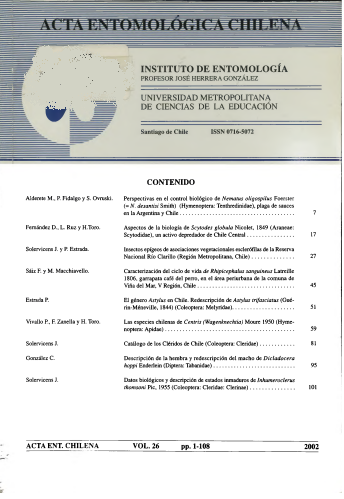Contenido principal del artículo
jul 4, 2022
Resumen
n a urban locality of Viña del Mar, V Región, Chile, with mediterranean climate, the Ufe cycle of Rhipicephalus sanguineus (brown dog tick) was studied between April 2000 and April 2001. The sampling
was carried out monthly in fifteen habitat units corresponding to houses that had a dog at least. Each habitat unit consisted of three microenvironments: exterior and interior of houses and body of domestic dog.
All the specimens of R. sanguineus were classified as larvae, nymphs and adults (females and males) according to microenvironments. A total of 2.400 specimens were collected: 13 larvae, 823 nymphs, 701 adult
males and 863 adult females. The presence of R. sanguineus was observed during the whole study, at least
in a type of microenvironment. Of the total specimens collected, 997 were found at the exterior of houses,
40 at the interior and 1.363 on dogs.
R. sanguineus remains latent in the exterior, mainly as an adult, during the coid months of May, June
and July. In August they are activated and infest progressively their host. During September the adults feed
and match up, diminishing their presence in the environment. In October the females begin the oviposition
in the extemal environment. The eclosión of larvae would take place in December. In January-February
the máximum presence of nymphs takes place, reaching adult’s State in March-April. In May the diapause
would begin, mainly as non feeding adults, being verified a life cycle of one year.


